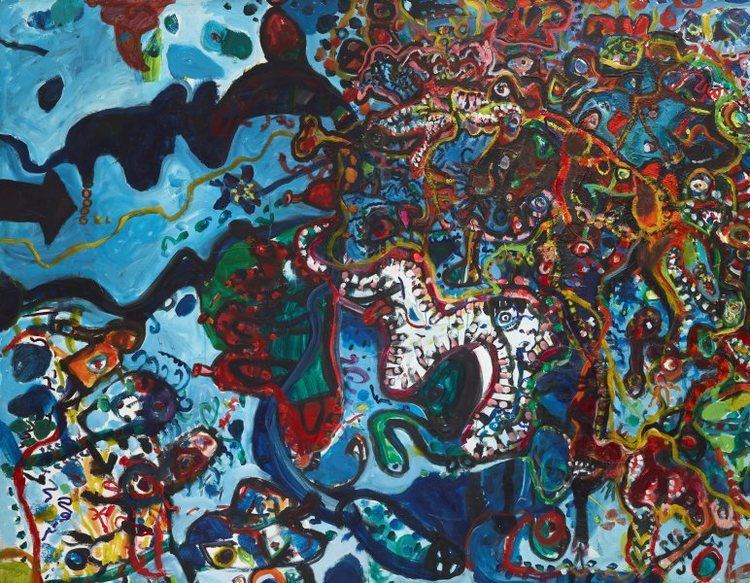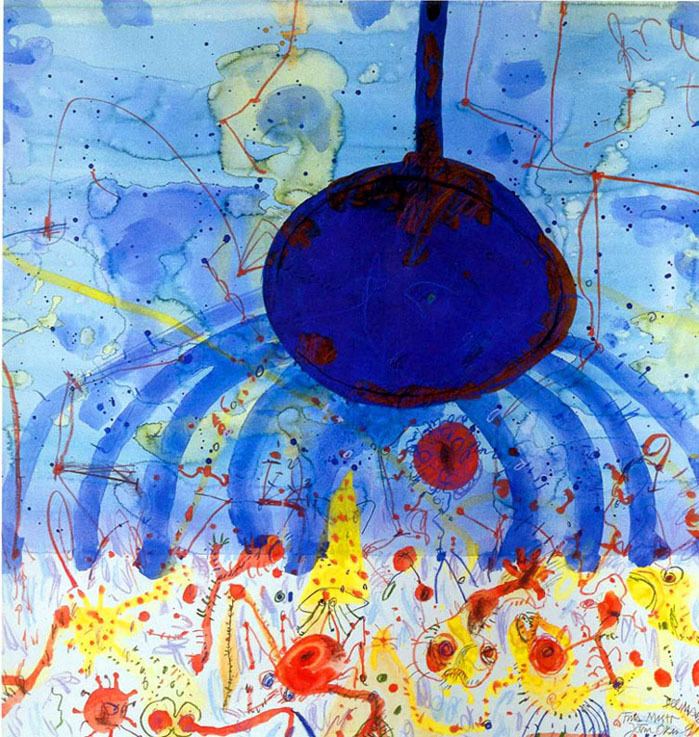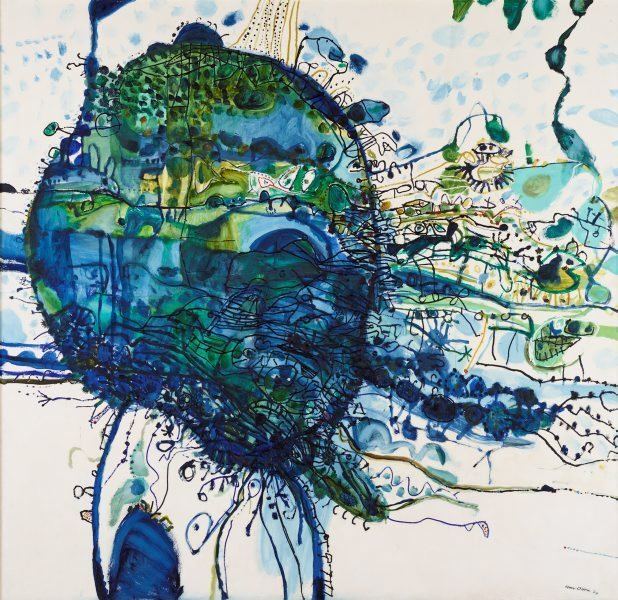Monarch Elizabeth II Name John Olsen | Role Artist | |
 | ||
Deputy Graham IngersonRob Kerin Artwork Popping Blue Bottles, Self portrait Janus Faced | ||
Ngv extra john olsen the artist
John Wayne Olsen, AO (born 7 June 1945) was Premier of South Australia between 28 November 1996 and 22 October 2001. He was twice the parliamentary leader of the South Australian Division of the Liberal Party of Australia in the South Australian House of Assembly, from 1982 to 1990 and again from 1996 to 2001. He unsuccessfully led the party to both the 1985 election and 1989 election.
Contents
- Ngv extra john olsen the artist
- Art series olsen
- Parliament
- Premier
- Policies
- Resignation
- Liberal State President
- References

In 1990, Olsen was appointed to a casual vacancy in the Australian Senate, but quit less than two years later to return to the South Australian House of Assembly at the 1992 Kavel by-election. He ran for the Liberal leadership but lost to Dean Brown, who successfully led the party to a landslide at the 1993 election. However, he successfully challenged Brown for the Premiership and Liberal leadership a year before the 1997 election. That election saw the SA Liberals win a second term for the first time ever, albeit while being reduced to minority government. He was forced to resign after he was found to have misled parliament during the Motorola affair, handing the premiership to Rob Kerin several months before the 2002 election where the Liberals lost government. Olsen is the longest-serving Liberal Party of Australia Premier of South Australia and the fourth-longest-serving Leader of the Opposition.

On 24 May 2017 Olsen announced that he had been asked to stand for the position of State President of the South Australian Division of the Liberal Party of Australia at a party vote on 16 June with cross-factional support, after incumbent Steve Murray stood down from the position on 23 May to contest the Davenport at the 2018 state election. Olsen was successful.

Art series olsen
Parliament

Olsen was first elected to the South Australian House of Assembly at the 1979 election as a Liberal in the Barossa Valley seat of Rocky River. He had previously been the last mayor of the Corporate Town of Kadina from 1974 to 1977. He represented this seat, renamed Custance at the 1985 election, until 1990.
Olsen's political career was marked by a bitter rivalry with Dean Brown, the two representing the conservative and moderate wings of the South Australian Liberal Party respectively. After the 1982 election and the electoral defeat and retirement of David Tonkin, Olsen defeated Brown for the state Liberal Party leadership and became Leader of the Opposition. Up against the Labor premier John Bannon, Olsen lost both the 1985 election and 1989 election. In the latter election, while the Liberals won a majority of the two-party vote (51.9 percent) with a five-seat swing, the party came up two seats short of forming majority government.
Olsen resigned as state Liberal leader soon after the election and returned to the backbench. He was appointed to the Australian Senate in 1990 to fill a casual vacancy caused by the resignation of Tony Messner.
However, in 1992, after less than two years in the Senate, he resigned to return to state politics. The Bannon government was under pressure from the collapse of the State Bank of South Australia. However, Olsen's successor as state Liberal leader, Dale Baker, was unable to gain significant ground. Baker resigned as state Liberal leader in 1992 and called a spill for all leadership positions, intending for Olsen to return to his old post. To facilitate this, former Deputy Premier Roger Goldsworthy, a leading member of the Liberals' right wing, resigned his Adelaide Hills seat of Kavel and handed it to Olsen. However, the party's moderate wing was unwilling to see the leadership handed to Olsen uncontested, and arranged for leading party moderate Ted Chapman to give up his seat of Alexandra so Brown could challenge for the leadership. Olsen returned to the House of Assembly at the 1992 Kavel by-election, on the same day as Brown at the 1992 Alexandra by-election. This time, Brown defeated Olsen in the leadership ballot, and thus became premier when the Liberals won the 1993 election in a landslide where the Liberals won 37 of the 47 seats available, the most that any party has won since the abolition of the Playmander. Olsen became Minister for Industry and Minister for Infrastructure until 1997, when a cabinet reshuffle saw him become Minister for Information Technology and Minister for Multicultural and Ethnic Affairs.
Soon after taking office, Olsen led negotiations with Motorola to build a software centre in Adelaide. Motorola decided to open the centre in April after winning a number of incentives, including becoming the supplier for a government radio network, and a contract was signed in June. During a September Question Time, Olsen stated that there had been no discussions with Motorola about the radio contract. This statement would ultimately prove to be his undoing.
Premier
By the fall of 1996, however, the Liberals' poll numbers under Dean Brown were stagnating in the face of factional battles and concerns about the slow pace of reform. With a statutory general election due in 1997, two prominent Liberal moderate backbenchers, Joan Hall (wife of former Premier Steele Hall) and Graham Ingerson, threw their support to Olsen. With Hall and Ingerson's support, Olsen again challenged for the party leadership in November 1996, this time succeeding and hence becoming Premier, with Ingerson as his deputy. It was the first time a Leader of the Opposition became Premier without winning an election first.
During the ensuing 1997 election campaign, most commentators agreed that Olsen lost the leaders' debate against Labor's Mike Rann. The election was extremely close; on election night many Liberals feared that Labor had managed the 12-seat swing it needed to take back government (Labor had taken two Liberal seats at by-elections). Ultimately, the Liberals suffered an 11-seat swing and were forced into a minority government supported by the SA Nationals and independent MPs. It was the first time that the main non-Labor party in South Australia had won a second term since adopting the Liberal Party label in 1974.
Policies
Among a number of controversial policies, Olsen's government undertook the privatisation of the state-owned electricity industry (ETSA), partly to improve the government's parlous financial situation due to the State Bank disaster and partly in response to the introduction of the Australian National Electricity Market, despite promising not to do so at the 1997 election. The fiscal arguments for privatisation were vigorously criticised by a number of economists.[1] Sharp increases in the retail price of electricity, a consequence of the working of the National Electricity Market, contributed to the growing unpopularity of the government.[2] The management of the state's water supply was privatised in 1996 with a $1.5bn 15-year contract being awarded to United Water, a subsidiary of Veolia.
Olsen steered water management and conservation projects, including the recycling of water from Adelaide's Bolivar Water Treatment Plant to the Northern Adelaide Plains. He also endorsed and facilitated the Barossa Water Project, a water distribution scheme from the River Murray to the Barossa Valley floor, alleviating the Barossa Valley winegrowers' water irrigation problems and boosting annual production by $30 million.
While in office, he negotiated a $850 million ‘smart-city' redevelopment of Adelaide's northern suburban area (Mawson Lakes) and facilitated the contract negotiations and construction of the Adelaide-Darwin Rail line.
The Olsen Government also secured major sporting events including the Tour Down Under and V8 Supercar Series. The Tour Down Under has become an economic plus for South Australia generating almost 40,000 visitors and $50million in economic benefit during the annual 5 day event. The V8 Supercar series attracts more than 270,000 attendees most years
He pursued a vigorous program of economic reform through the corporatisation and privatisation of government services which included the single largest public outsourcing project of its kind at the time in the world – the outsourcing of the State's water industry, a contract which included the establishment of a private sector water industry.
Resignation
By the end of 1998, questions about the Motorola deal had grown so voluminous that the government was forced to establish a committee of inquiry into the matter, chaired by former chief magistrate Jim Cramond. The inquiry ultimately found that Olsen had misled parliament, and also found that Olsen had made representations to Cramond that were labelled "misleading and inaccurate", "dishonest" and had "no factual basis".
Olsen denied any wrongdoing by saying "...I absolutely refute Mr Clayton's assertion. The report clearly indicates there are no criminal activities, no illegal activities." Nonetheless, amid speculation that he would face a leadership challenge, he resigned as Premier on 10 October 2001. He did not run for reelection in 2002.
Since leaving South Australian politics, Olsen was appointed by the John Howard federal Liberal government as Australian Consul-General to Los Angeles. On 7 December 2005, his Liberal Party colleague and fellow South Australian, the then Australian Foreign Minister, Alexander Downer announced that Olsen would become the new Australian Consul-General in New York. He was appointed an Officer of the Order of Australia in January 2007.
Most recently, Olsen was appointed as Deputy chairman/CEO of the American Australian Association Ltd.
As of 2014 Olsen is the President of the South Australian National Football League (SANFL), and is also the Chairman of the SA Football Commission, positions he has held since 2010. He is also a Life Member of the West Adelaide Football Club with whom he was the No. 1 ticket holder for 17 years.
Olsen is a registered political lobbyist and has worked with Bespoke Approach as a Special Advisor.
Liberal State President
On 24 May 2017 Olsen announced that he had been asked to stand for the position of State President of the South Australian Division of the Liberal Party of Australia at a party vote on 16 June with cross-factional support, after incumbent Steve Murray stood down from the position on 23 May to contest the Davenport at the 2018 state election. Olsen was successful.
He was previously state president in 1979, before his election to the seat of Rocky River.
